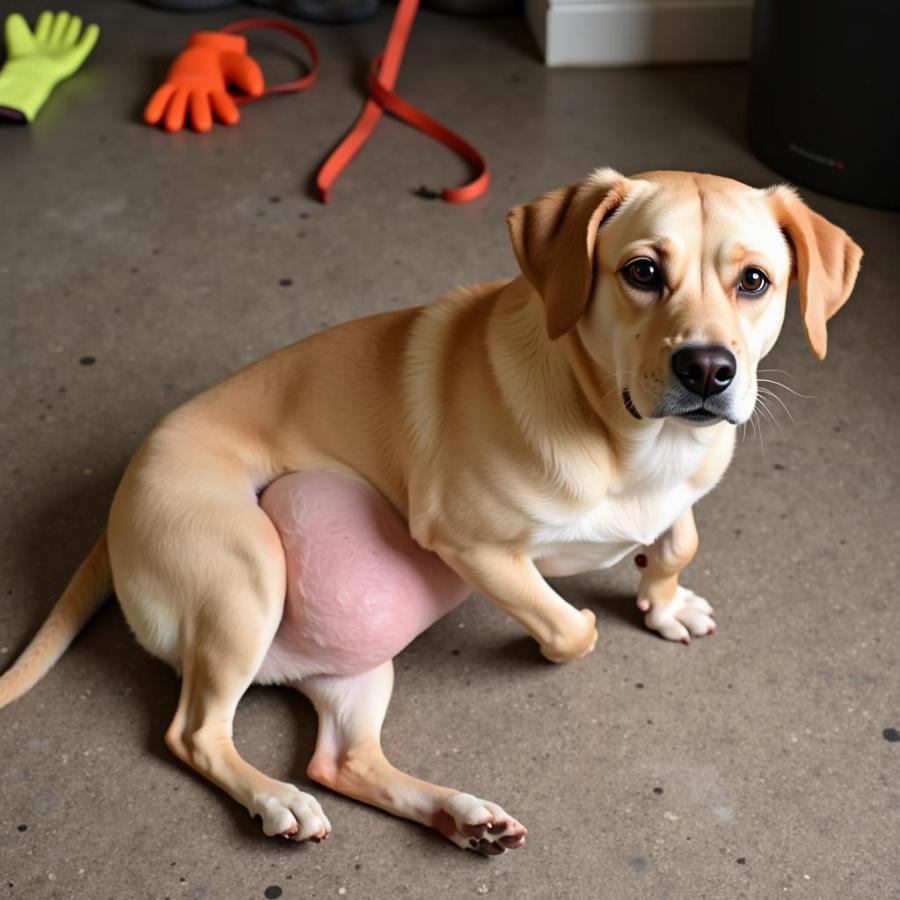Poison ivy on dogs can be a real nuisance. It’s important to know what poison ivy looks like on your furry friend so you can take action quickly. This article will guide you through identifying, treating, and preventing poison ivy exposure in dogs. We’ll cover everything from the initial contact to the aftercare, so you can be prepared to protect your canine companion.
Recognizing Poison Ivy on Your Dog
So, what does poison ivy look like on a dog? Unlike in humans where a rash is immediately apparent, it’s not always easy to spot on a dog’s fur. Look for redness, swelling, and blisters, particularly on areas with less fur like the belly, groin, and paws. Your dog might also be excessively licking or scratching the affected area. The tricky part is that the initial contact point might be hidden under their fur.
The oil from poison ivy, called urushiol, is the culprit behind the allergic reaction. Even a small amount can cause significant irritation. If your dog brushes against poison ivy, they can transfer the oil to other parts of their body, or even to you!
Symptoms of Poison Ivy Exposure in Dogs
Beyond the visible signs, what other symptoms might your dog exhibit? Intense itching is the most common. You might notice your dog constantly licking, chewing, or scratching the affected area. In some cases, this can lead to secondary infections from broken skin. Other signs can include lethargy, loss of appetite, and fever.
 Symptoms of Poison Ivy on Dogs
Symptoms of Poison Ivy on Dogs
If you suspect your dog has come into contact with poison ivy, it’s essential to act quickly. The sooner you address the issue, the better the chances of minimizing discomfort and preventing secondary infections.
Treating Poison Ivy on Dogs
If you think your dog has encountered poison ivy, the first step is to wash the affected area thoroughly with lukewarm water and a pet-safe soap. Avoid using human shampoos as they can irritate the already sensitive skin. You can also use a dog washing glove for a more thorough cleaning.
Remember that the urushiol can stick to your skin, too. Wear gloves while washing your dog to protect yourself. After washing, rinse thoroughly to remove all traces of soap and urushiol.
While calamine lotion and dogs might seem like a good idea, it’s best to consult with your veterinarian before applying any topical medications. They can recommend appropriate treatments based on the severity of the reaction. In some cases, your vet might prescribe antihistamines or steroids to reduce inflammation and itching.
Preventing Poison Ivy Exposure
Prevention is always better than cure. Learn to identify poison ivy in your yard and surrounding areas. Poison ivy on dogs photos can help you recognize this plant. Keep your dog on a leash during walks in areas where poison ivy might be present. Regular grooming can also help remove urushiol from your dog’s fur before it causes a reaction.
What if my dog ate poison ivy?
While less common, a dog might ingest poison ivy. This can cause gastrointestinal upset like vomiting and diarrhea. Contact your vet immediately if you suspect your dog has eaten poison ivy.
Can poison ivy spread from my dog to me or other pets?
While the rash itself isn’t contagious, the urushiol oil can be. If your dog has urushiol on their fur, it can be transferred to you or other pets through direct contact. Thorough handwashing after handling your dog is crucial.
Conclusion
Knowing what poison ivy looks like on a dog, understanding the symptoms, and knowing how to treat and prevent exposure are essential for responsible dog ownership. By being proactive and informed, you can help your furry friend avoid the discomfort of poison ivy. Remember to always consult with your veterinarian if you have any concerns about your dog’s health.
FAQ
- What is the first thing I should do if I think my dog has poison ivy? Wash the affected area thoroughly with lukewarm water and pet-safe soap, wearing gloves to protect yourself.
- Can I use human calamine lotion on my dog? No, consult with your veterinarian before applying any topical medications to your dog.
- How can I prevent my dog from getting poison ivy? Learn to identify poison ivy, keep your dog on a leash in areas where it grows, and groom your dog regularly.
- Is poison ivy contagious from dogs to humans? The rash itself isn’t contagious, but the urushiol oil can be transferred from your dog to you.
- What if my dog eats poison ivy? Contact your veterinarian immediately if you suspect your dog has ingested poison ivy.
- What are the signs of a poison ivy reaction in dogs? Redness, swelling, blisters, intense itching, licking, chewing, scratching, lethargy, loss of appetite, and fever.
- Where is poison ivy most likely to affect a dog? Areas with less fur, such as the belly, groin, and paws.
Beaut Dogs is your trusted source for all things dog-related. We offer expert advice and information on dog breeds, care, and more. poison ivy dog can be a concern for pet owners, and we’re here to help you navigate this issue. When in doubt, always contact your vet or email us at [email protected] for detailed and accurate advice. Beaut Dogs is dedicated to providing reliable, helpful, and in-depth information about the canine world.